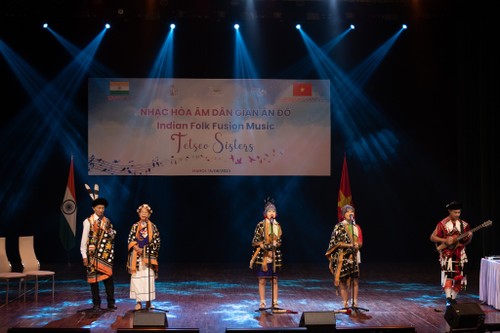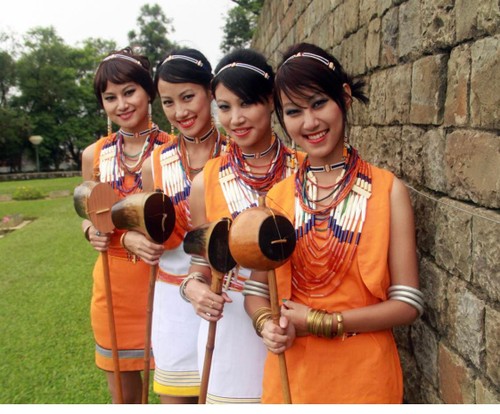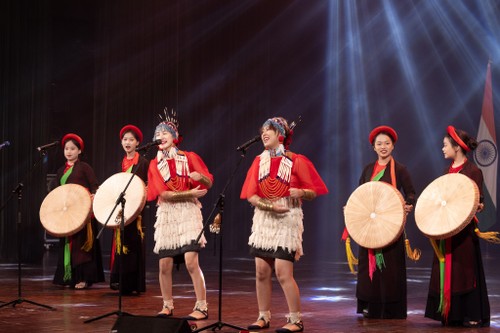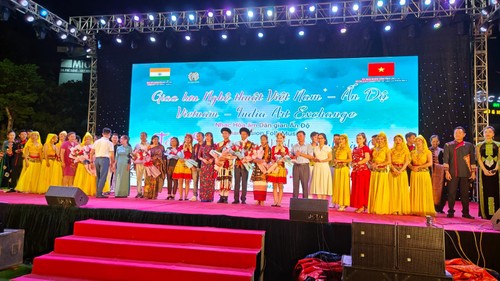 Tetseo Sisters presented a scintillating performance of folk fusion act at Au Co Art Centre, Hanoi, on Independence Day evening. (Photo: Embassy of India, Hanoi) Tetseo Sisters presented a scintillating performance of folk fusion act at Au Co Art Centre, Hanoi, on Independence Day evening. (Photo: Embassy of India, Hanoi)
|
Tati is one expression of the Li, a folk song form of the Chokri people from the Chakhesang Naga tribe in India.
Li is considered a way of life and a form of folk media through which cultural values are passed down through generations.
Kuvelü Tetseo, a member and composer of the Tetso Sisters, a famous Indian folk music band from Nagaland, said that Li in the Chokri language specifically refers to folk music of the Chakhesang tribe of Nagaland in India.
“The special and unique characteristic of Li is that it has songs for every occasion, whether it is a celebration, festival, or harvest. It could be a lullaby, or even for a song for the mourning of a loss. We have songs about women and men and anything. Just give us the topic and a song can be created for it,” Kuvelü explained.
 The Testeo Sisters with their accompanying instrument, Tati. The Testeo Sisters with their accompanying instrument, Tati.
|
Some Lis are accompanied by musical instruments, the most notable of which is the indigenous instrument known as Tati or Libuh, a one-stringed musical instrument.
This instrument, measuring about 3-4 feet in length, is made of a dried carved-out bottle gourd. This bottle gourd is covered with thin film and attached to one end of a pole which is made of a special kind of bamboo known as Ruki and Dithuh also. A string is tied between the two ends of the pole over the film-covered bottle gourd. It resembles the Indian ektara and is plucked to make a sound, which provides rhythm and guides the pitch for a singer.
Kuvelü said the instrument can be played by a single person or by a group of people in unison creating a harmony.
“I mean, the unique thing about Li, the folk song that we sing, is that we can sing a capella. But Tati goes really well with the music we sing. It's not indispensable, but it goes well and it's very compatible,” said Kuvelü.
 Kuvelü Tetseo and Alüne Tetseo join artists of Quan Ho Folk Theater in a performance at Au Co Art Centre in Hanoi (Photo: Embassy of India, Hanoi) Kuvelü Tetseo and Alüne Tetseo join artists of Quan Ho Folk Theater in a performance at Au Co Art Centre in Hanoi (Photo: Embassy of India, Hanoi) |
Founded in 1994, the Tetseo Sisters are a folk fusion quartet band from the city of Kohima. The siblings have spent their young lives promoting the legacy of Li, the nearly forgotten music of the Chakhesang Naga tribe, which has been passed down from their parents.
The group’s songs are melodious, focused on vocal harmonies - rich in tones and nuances -culminating in a startlingly perfect blend of rhymes and rhythm. Tetseo Sisters sing about life lessons, nature, love and friendship, hope, courage and youthful ambitions, values, time, and living an inspiring life.
Over the years, the Tetseo Sisters have made a niche for themselves, becoming more popular not only in the state or India, but across the world. Their parents are the people behind the success of the Tetseo sisters.
Kuvelü and her youngest sister Alüne Tetseo said how lucky they are to have their parents to have really trained them since they were very young, although they don't have older generations who can really teach them how to sing or how to play the instrument. “My mom is very strict when it comes to training. She trained us really well when we were younger and now we feel that we should do more. We are also trying hard to keep up the standard,” said Kuvelü.
The Tetseo Sisters call themselves storytellers who present songs passed down the traditional oral way to their audiences in their pristine form, but often with a contemporary twist.
Their performance repertoire includes original English, Hindi, and Chokri contemporary and folk fusion songs as well as covers of modern pop songs, according to Alüne Tetseo, the youngest in the band.
“I think with every gift comes responsibility and we are very proud and honored to be the ambassadors back home for folk music and to also be able to present that outside the country,” said Alüne, adding, “We're doing our best every day documenting our work. We have a website called tetseosisters.com where we not only post our music, but also the stories behind all the songs that we've written, and all the forgotten folk tales and stories passed on from generation from generation which our parents and our grandmothers have taught us. So, we've been documenting them and putting our music on YouTube.”
Adorned in the traditional Naga garb, these cultural ambassadors have been warmly received and appreciated whenever they have shared their music.
Both Kuvelü and Alüne said proudly that fusing folk song into modern fusion is what the Tetso Sisters have done to keep in mind the interest of young listeners.
They said they have received positive responses wherever they have been to, whether it's in schools, in church, in temple, outside the street, or even in a restaurant.
 Tetseo Sisters' performance at Dinh Le – An Duong Vuong Square, Lao Cai City, Lao Cai Province on 12 August 2023. (Photo: Embassy of India, Hanoi) Tetseo Sisters' performance at Dinh Le – An Duong Vuong Square, Lao Cai City, Lao Cai Province on 12 August 2023. (Photo: Embassy of India, Hanoi)
|
The Tetseo Sisters have been sought out as resources and experts in Naga tribal culture, inspiring many young people and tribes to initiate efforts to preserve their own native language, culture, and music.
Kuvelü said all the band members believe that the young generation should know where they come from, where the identity and the roots come from and took them as an example as in the early days they were taught by their parents about the folk songs and the stories behind it.
“And it encouraged us and you know, it gave us the feeling of duty. You feel that you have a duty and responsibility to preserve that and pass that and record that for the future generations so that it can be a legacy because once it's forgotten, it'll be gone forever. We don't want that. And that's how it all started,” said Kuvelü.
“We didn't really plan to become ambassadors of our folk music, but then over the years we learned that our new generation has forgotten where our roots are. So, we felt that we should carry on that responsibility. That's what we have been trying to do in our own level, doing a little bit,” Kuvelü concluded.
Their efforts are seen as strong representatives of the northeast of India and facilitators of national integration with their music and presence and officially recognized as NE Nari Shakti Cultural Ambassadors by the Ministry of Development of Northeastern Region in 2022.